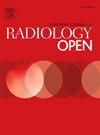Assessment of bone-implant interface image quality for in-vivo acetabular cup implants using photon-counting detector CT: Impact of tin pre-filtration
IF 2.9
Q3 RADIOLOGY, NUCLEAR MEDICINE & MEDICAL IMAGING
引用次数: 0
Abstract
Purpose
To assess the image quality of the bone-implant interface of acetabular cup implants using photon-counting detector (PCD) CT with and without tin pre-filtration in a clinical setting.
Methods and materials
Twenty-four patients underwent PCD-CT imaging of their total hip replacement (THR). Twelve patients were scanned using 140 kVp and twelve patients using 140 kVp with tin pre-filtration (Sn140 kVp). All scans were acquired with a collimation of 120 × 0.2 mm. The acquired data was reconstructed with different slice thickness (0.2 mm – 0.6 mm) and kernel (Qr) strengths (56, 76, 89) with and without metal artifact reduction (iMAR). Two observers assessed the image quality of the bone-implant interface for the cup based on four image quality criteria. Bone contrast, contrast-to-noise ratio (CNR) of bone/fat and cortical sharpness was performed as quantitative measures.
Results
Image quality was rated highest for 0.2 mm slice thickness and Qr89 kernel across all four criteria for both the 140 kVp and Sn140 kVp by both observers, with a slight preference for the Sn140kVp over the 140 kVp. In all cases and for all image criteria the 0.2 mm/Qr89 was preferred above the Qr76 and Qr56/iMAR for both the 140 kVp and Sn140 kVp by both observers. Quantitative measurements confirmed significantly improved bone contrast as well as cortical sharpness using 0.2 mm/Qr89. Tin pre-filtration did not affect the CNR at 0.2 mm/Qr89 but tended to decrease cortical sharpness.
Conclusions
High resolution PCD-CT allows for in-vivo assessment of the bone-implant interface in patients with THR and is preferably acquired with tin pre-filtration.
利用光子计数检测器CT评估体内髋臼杯植入物骨-植入物界面图像质量:锡预过滤的影响
目的在临床应用光子计数CT (PCD)对有锡预滤和无锡预滤的髋臼杯状假体骨-假体界面图像质量进行评价。方法与材料24例患者行全髋关节置换术(THR)的PCD-CT成像。12例患者使用140 kVp进行扫描,12例患者使用140 kVp进行锡预过滤(Sn140 kVp)。所有扫描都是在120 × 0.2 mm的准直下获得的。用不同的切片厚度(0.2 mm - 0.6 mm)和核(Qr)强度(56、76、89)对采集的数据进行重建,并进行金属伪影还原(iMAR)。两名观察员根据四项图像质量标准评估骨-种植体杯界面的图像质量。骨对比,骨/脂肪对比噪声比(CNR)和皮质锐度作为定量测量。结果在140kVp和Sn140kVp的所有四个标准中,两个观察者对0.2 mm切片厚度和Qr89内核的图像质量评价最高,Sn140kVp略高于140kVp。在所有情况下,对于所有图像标准,对于140 kVp和Sn140 kVp, 0.2 mm/Qr89优于Qr76和Qr56/iMAR。定量测量证实,使用0.2 mm/Qr89可显著改善骨对比和皮质锐度。在0.2 mm/Qr89时,锡预滤不影响CNR,但有降低皮质锐度的趋势。结论高分辨率PCD-CT可以在体内评估THR患者的骨-种植体界面,并且最好通过锡预过滤获得。
本文章由计算机程序翻译,如有差异,请以英文原文为准。
求助全文
约1分钟内获得全文
求助全文
来源期刊

European Journal of Radiology Open
Medicine-Radiology, Nuclear Medicine and Imaging
CiteScore
4.10
自引率
5.00%
发文量
55
审稿时长
51 days
 求助内容:
求助内容: 应助结果提醒方式:
应助结果提醒方式:


